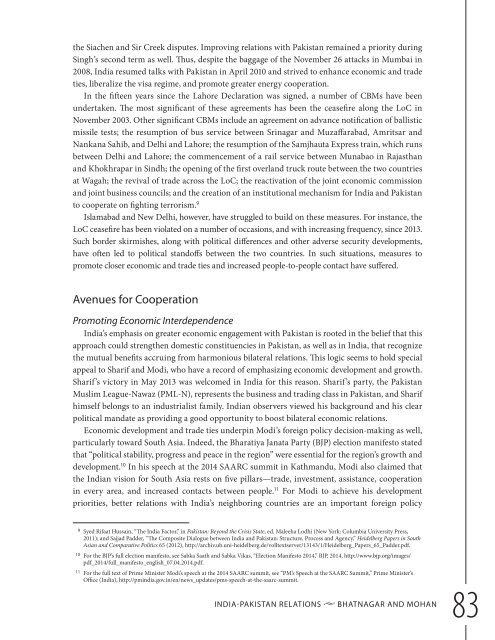pakistan’s
SR55_Mapping_Pakistan_February2016
SR55_Mapping_Pakistan_February2016
Create successful ePaper yourself
Turn your PDF publications into a flip-book with our unique Google optimized e-Paper software.
the Siachen and Sir Creek disputes. Improving relations with Pakistan remained a priority during<br />
Singh’s second term as well. Thus, despite the baggage of the November 26 attacks in Mumbai in<br />
2008, India resumed talks with Pakistan in April 2010 and strived to enhance economic and trade<br />
ties, liberalize the visa regime, and promote greater energy cooperation.<br />
In the fiteen years since the Lahore Declaration was signed, a number of CBMs have been<br />
undertaken. The most significant of these agreements has been the ceasefire along the LoC in<br />
November 2003. Other significant CBMs include an agreement on advance notification of ballistic<br />
missile tests; the resumption of bus service between Srinagar and Muzaffarabad, Amritsar and<br />
Nankana Sahib, and Delhi and Lahore; the resumption of the Samjhauta Express train, which runs<br />
between Delhi and Lahore; the commencement of a rail service between Munabao in Rajasthan<br />
and Khokhrapar in Sindh; the opening of the first overland truck route between the two countries<br />
at Wagah; the revival of trade across the LoC; the reactivation of the joint economic commission<br />
and joint business councils; and the creation of an institutional mechanism for India and Pakistan<br />
to cooperate on fighting terrorism. 9<br />
Islamabad and New Delhi, however, have struggled to build on these measures. For instance, the<br />
LoC ceasefire has been violated on a number of occasions, and with increasing frequency, since 2013.<br />
Such border skirmishes, along with political differences and other adverse security developments,<br />
have oten led to political standoffs between the two countries. In such situations, measures to<br />
promote closer economic and trade ties and increased people-to-people contact have suffered.<br />
Avenues for Cooperation<br />
Promoting Economic Interdependence<br />
India’s emphasis on greater economic engagement with Pakistan is rooted in the belief that this<br />
approach could strengthen domestic constituencies in Pakistan, as well as in India, that recognize<br />
the mutual benefits accruing from harmonious bilateral relations. This logic seems to hold special<br />
appeal to Sharif and Modi, who have a record of emphasizing economic development and growth.<br />
Sharif’s victory in May 2013 was welcomed in India for this reason. Sharif’s party, the Pakistan<br />
Muslim League-Nawaz (PML-N), represents the business and trading class in Pakistan, and Sharif<br />
himself belongs to an industrialist family. Indian observers viewed his background and his clear<br />
political mandate as providing a good opportunity to boost bilateral economic relations.<br />
Economic development and trade ties underpin Modi’s foreign policy decision-making as well,<br />
particularly toward South Asia. Indeed, the Bharatiya Janata Party (BJP) election manifesto stated<br />
that “political stability, progress and peace in the region” were essential for the region’s growth and<br />
development. 10 In his speech at the 2014 SAARC summit in Kathmandu, Modi also claimed that<br />
the Indian vision for South Asia rests on five pillars—trade, investment, assistance, cooperation<br />
in every area, and increased contacts between people. 11 For Modi to achieve his development<br />
priorities, better relations with India’s neighboring countries are an important foreign policy<br />
9 Syed Rifaat Hussain, “The India Factor,” in Pakistan: Beyond the Crisis State, ed. Maleeha Lodhi (New York: Columbia University Press,<br />
2011); and Sajjad Padder, “The Composite Dialogue between India and Pakistan: Structure, Process and Agency,” Heidelberg Papers in South<br />
Asian and Comparative Politics 65 (2012), http://archiv.ub.uni-heidelberg.de/volltextserver/13143/1/Heidelberg_Papers_65_Padder.pdf.<br />
10 For the BJP’s full election manifesto, see Sabka Saath and Sabka Vikas, “Election Manifesto 2014,” BJP, 2014, http://www.bjp.org/images/<br />
pdf_2014/full_manifesto_english_07.04.2014.pdf.<br />
11 For the full text of Prime Minister Modi’s speech at the 2014 SAARC summit, see “PM’s Speech at the SAARC Summit,” Prime Minister’s<br />
Office (India), http://pmindia.gov.in/en/news_updates/pms-speech-at-the-saarc-summit.<br />
INDIA-PAKISTAN RELATIONS u BHATNAGAR AND MOHAN<br />
83



